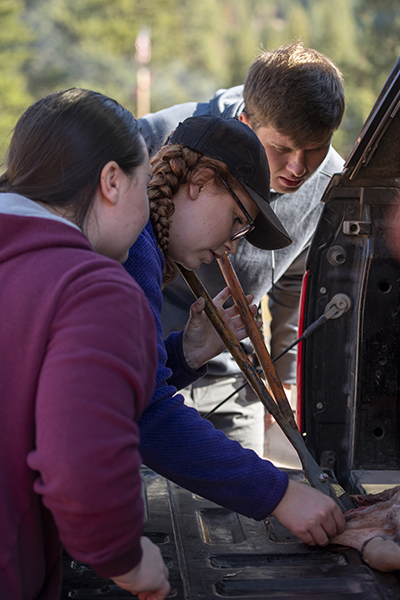Bonner, MT – Traffic jams are rare in this historic mill town east of Missoula, but when they happen the locals know it can only be one of two things: There’s a concert at the KettleHouse Amphitheater or it’s hunting season in the Big Sky State.
Bonner is one of several sites on the western side of the state where Montana Fish, Wildlife and Parks (big game) and the Confederated Salish and Kootenai Tribes (waterfowl and upland birds) host hunter check stations. On any given fall weekend, up to 1,000 hunters will que up as required by law to report their harvest – or lack thereof.
With assistance from University of Montana students, wildlife biologists use the stations to gain valuable insights into the health of Montana’s big game and bird populations.
The students working alongside Ebinger and other FWP staff are enrolled in Wild 374, an experiential learning course conducted by UM’s Montana Cooperative Wildlife Research Unit and the W.A. Franke College of Forestry and Conservation. The class, which meets just once in a classroom during the fall semester, requires students to work four days at check stations during hunting season and complete a term paper on their experiences.
“I transferred from a school in Oregon a year ago because UM offers so many classes with some hands-on components like this,” said Lily McPherson, a senior environmental studies and sustainability major who worked opening day at the Bonner station. “It is definitely interesting to be that up close to such big animals.”
Like McPherson, other students cited the opportunity to get experience out in the field for enrolling in the course, as well as becoming better acquainted with the rich diversity of Montana wildlife.
“For many students, this is their first taste of what it’s like to work as a wildlife biologist,” said Rebecca Mowry, an FWP wildlife biologist who’s operated the hunter check station in Darby for the past 10 years. “It provides an opportunity to see up close the animals that come through here.”
Mowry added that she has run into graduates of the program as far away as Texas who previously worked in Darby.
“I tell students they should never pass up opportunities to network with professionals who have the jobs they dream of,” said Chad Bishop, director of UM’s Wildlife Biology Program. “Days spent at the check points give students enrolled in this class valuable time for this interaction.”
Bishop and Ebinger cautioned students in the initial class that while each day at the station will be unique, there will be certainties, including cold and wet weather. Appropriate dress is key, as is being willing to hop in and out of muddy truck beds.
“There will be blood,” Ebinger said. “And you will hear complaints about wolves and Montana’s paper tagging system.
“You will be using a lot of electrical tape to put the tags back on animals,” he added.
Shifts at the check stations typically last from 10:30 a.m. until 8 p.m. Students assist with recording basic information, such as where an animal was harvested, its sex and, when applicable, its number of antler points.
Aging the animals gets a bit more complicated. It involves slicing the animal’s cheek and using large vices to open the jaw to examine the teeth. For many hunters, this is a chance to learn more about the animal they’ve harvested. Wear equals age, they learn, as does the eruption of molars.
“As Mike likes to say, aging an animal is more an art than a science,” said wildlife biology sophomore Malakhi Spint. “I think I’ve gotten better at it, but then like today we had an animal that had a deformed molar so it was more difficult.”
Talking with the hunters and seeing their interest in learning more about the animals they’ve harvested, and the general success of fellow hunters that day, has been a learning experience, Spint added.
“Some are pretty chatty and that’s nice,” he said. “This has been rewarding both as a student and as a fellow hunter myself.”
“Yeah, the unsuccessful hunters weren’t the happiest,” said McPherson of opening day. “But those who got an elk or deer were definitely down to chat.”
Interacting with the public is a key component of the job – one that students need to embrace to be successful.
“From my perspective, the most important thing for students is to see how we interact with the public and to see if they like that part of the job,” Ebinger said. “A lot of people get into wildlife because they don’t want to work with people but in the end, we are managing wildlife for people so you are a public servant and it is a people person job.”
By Raequel Roberts, UM News Service




